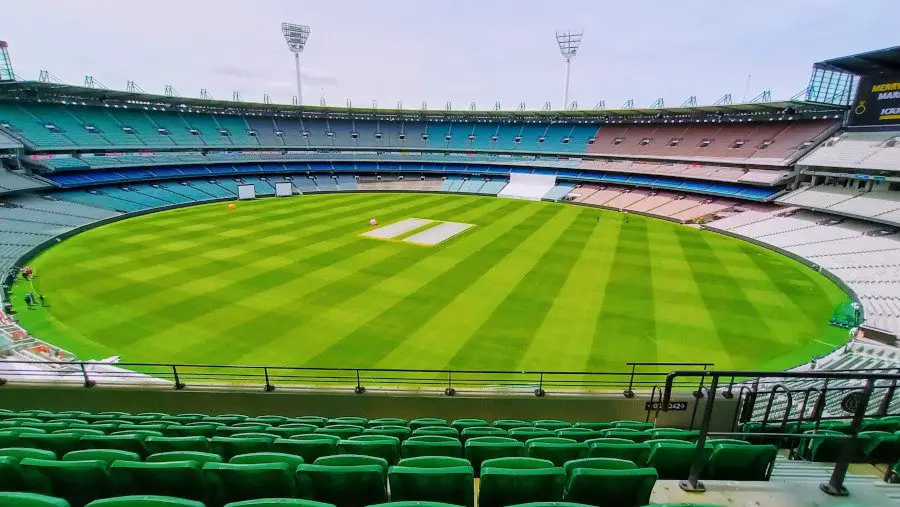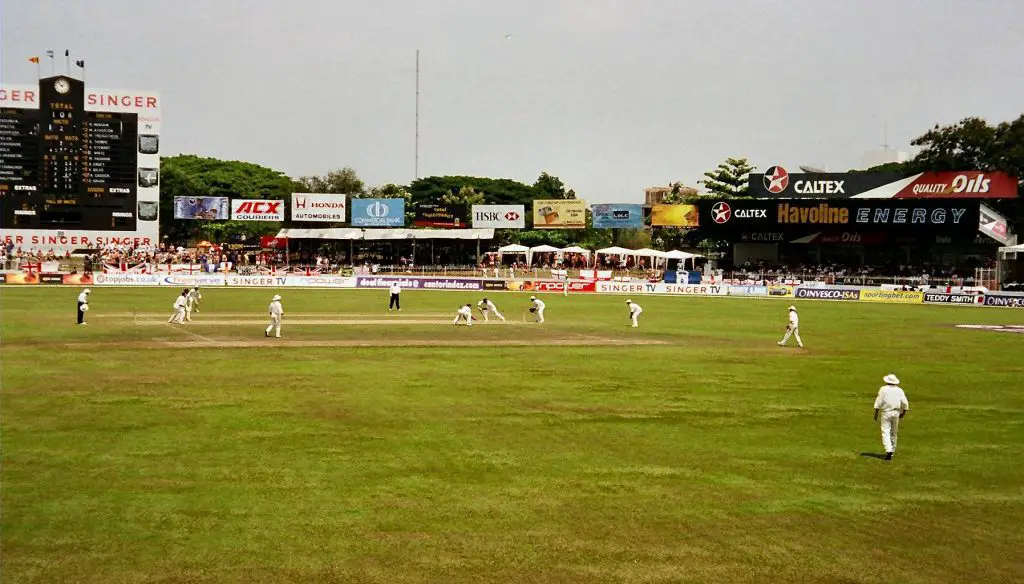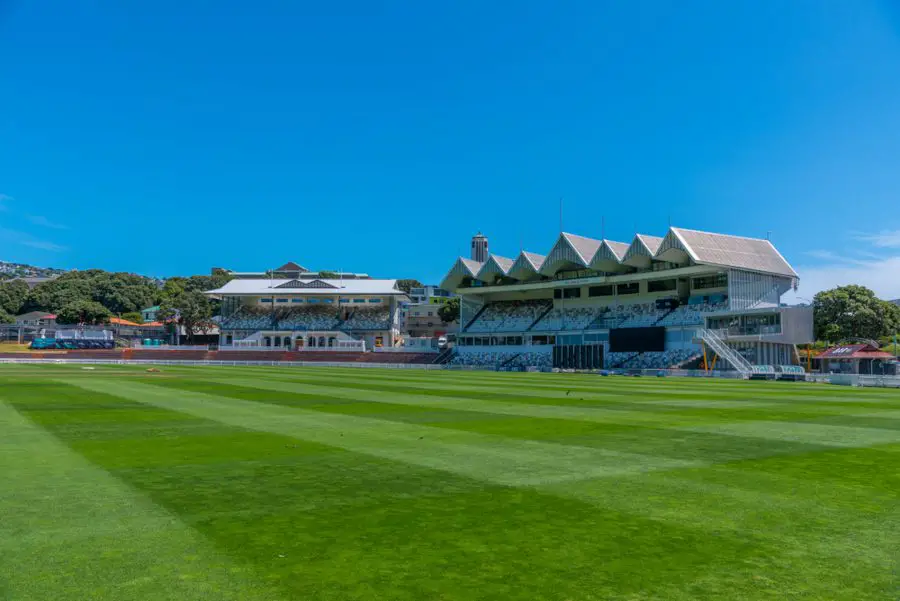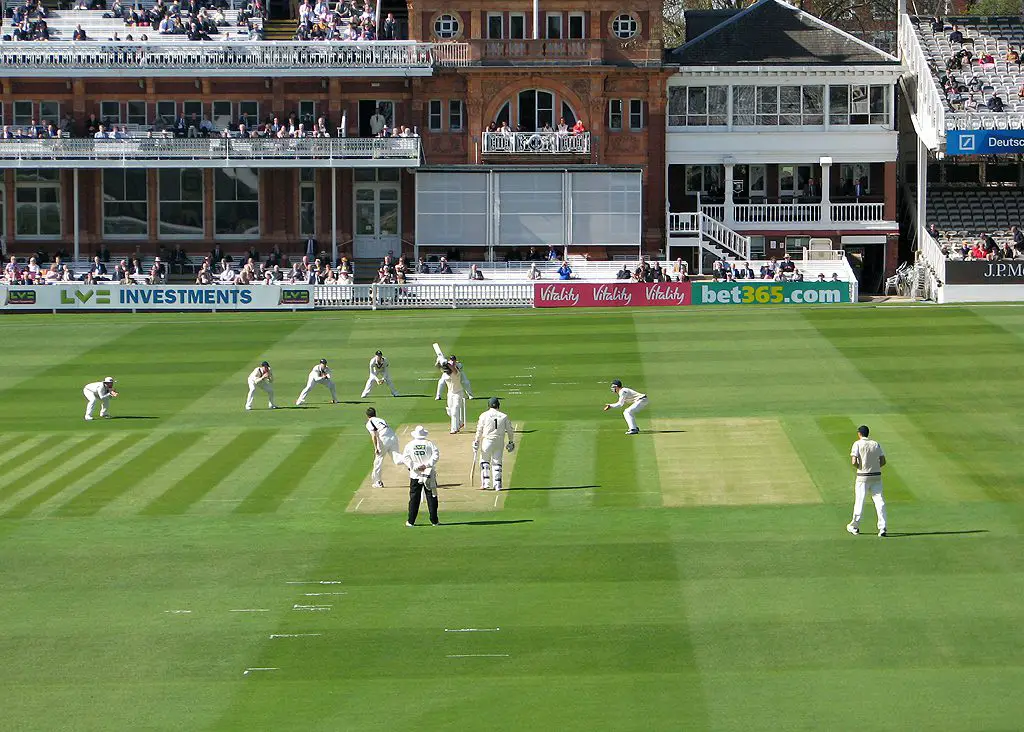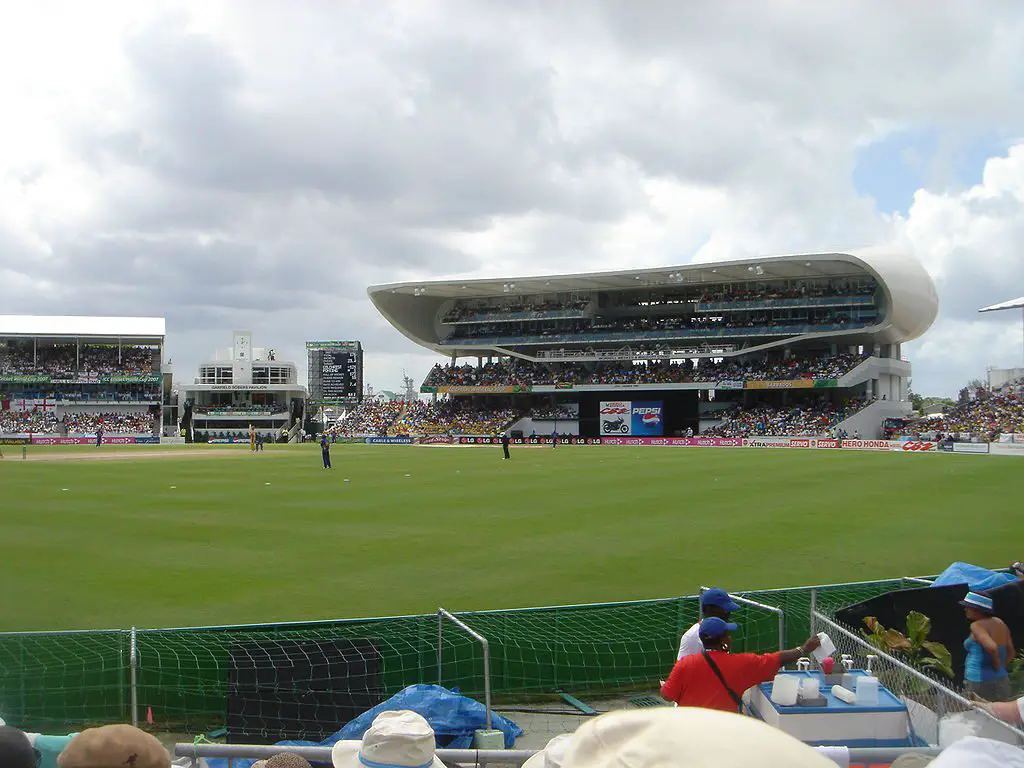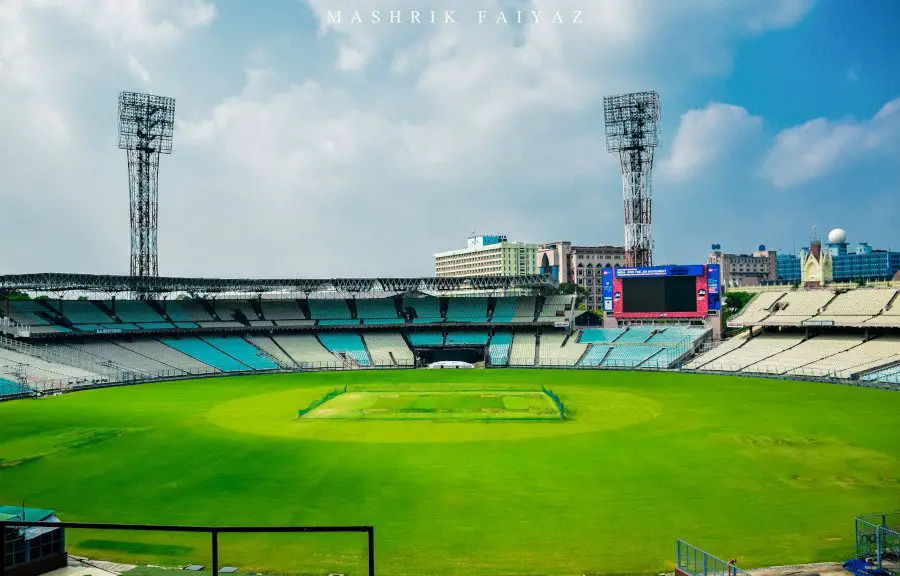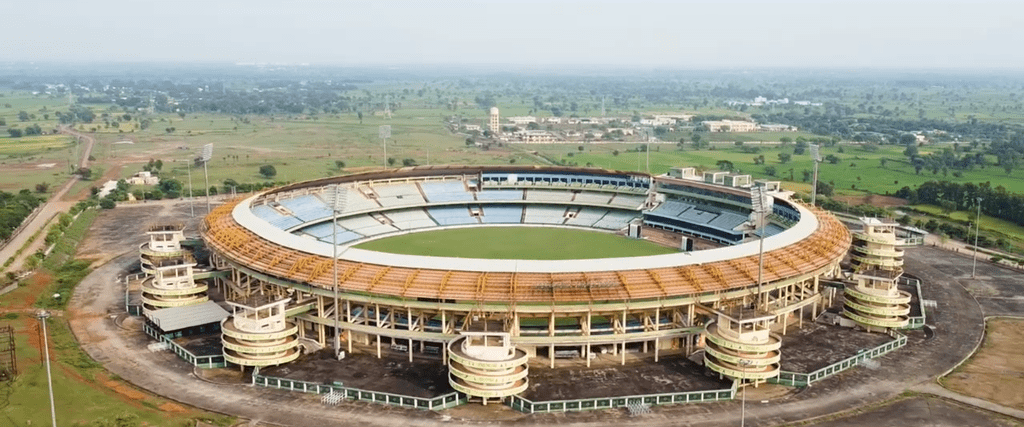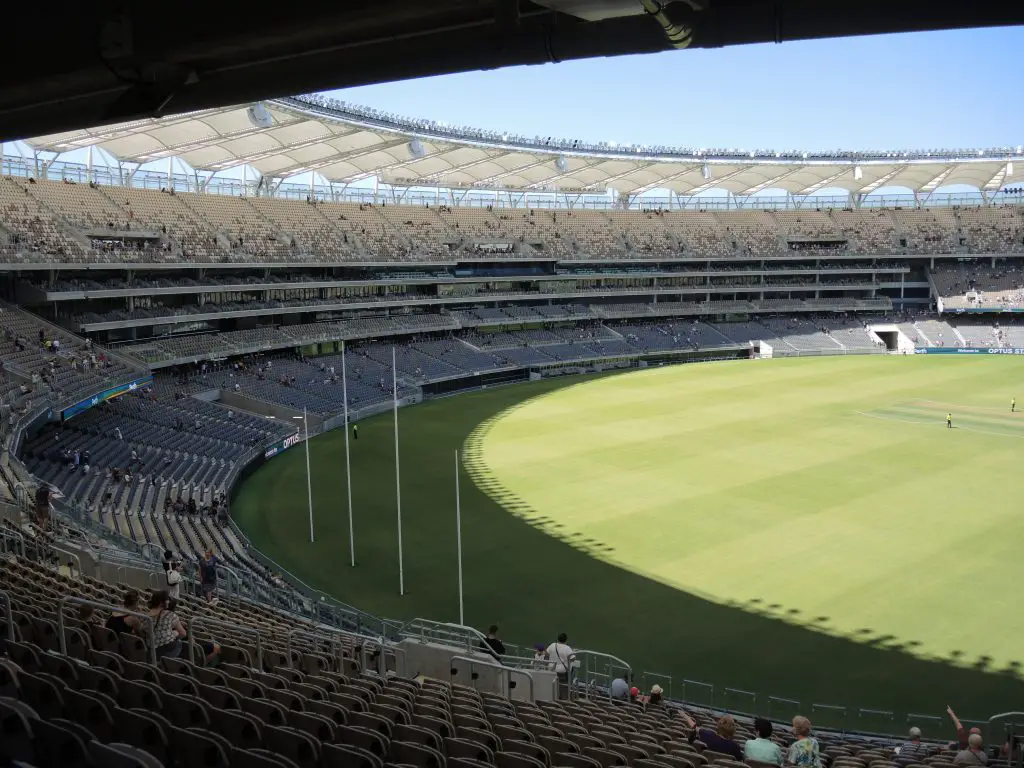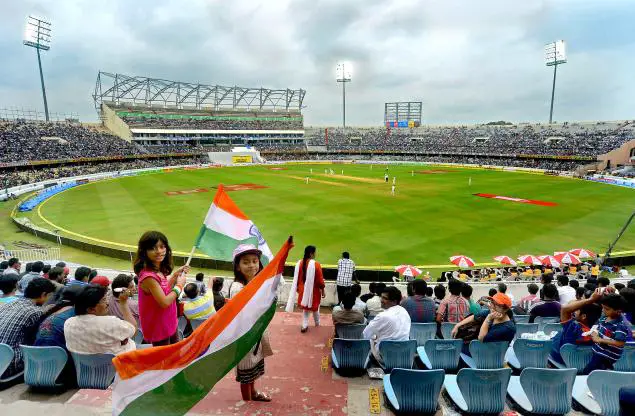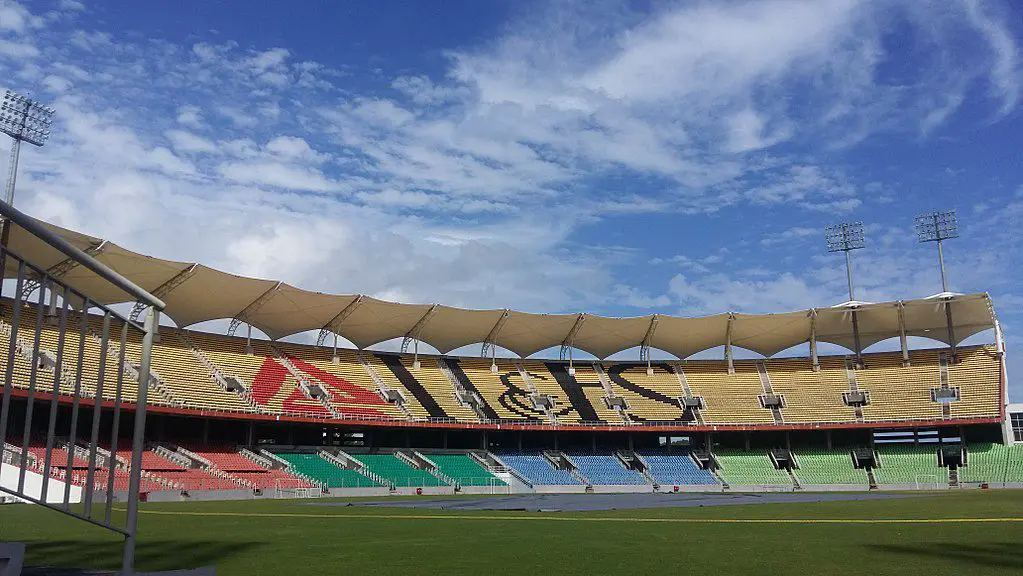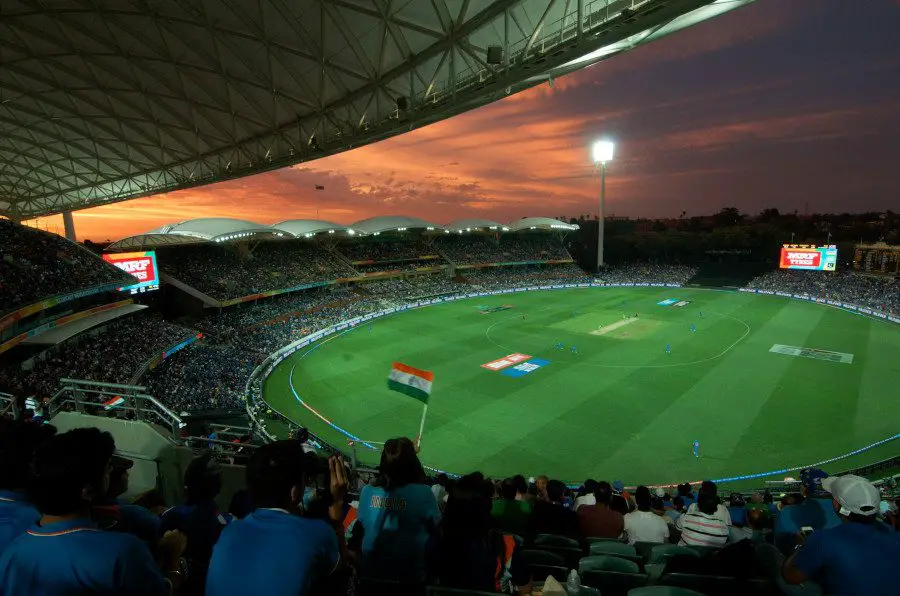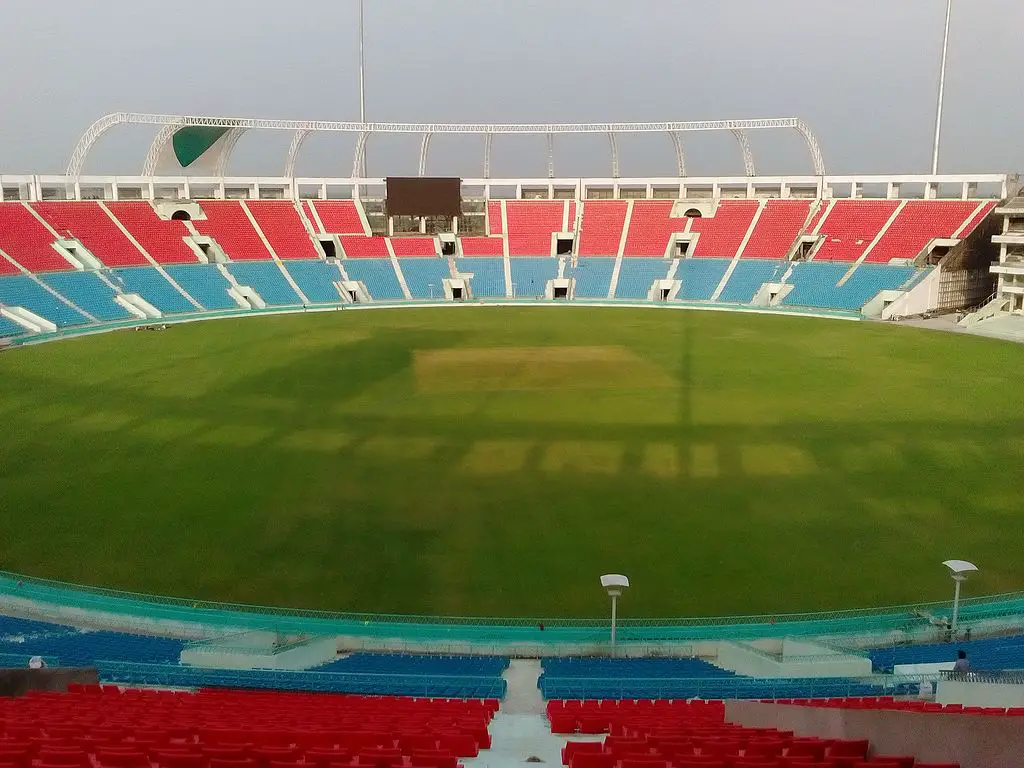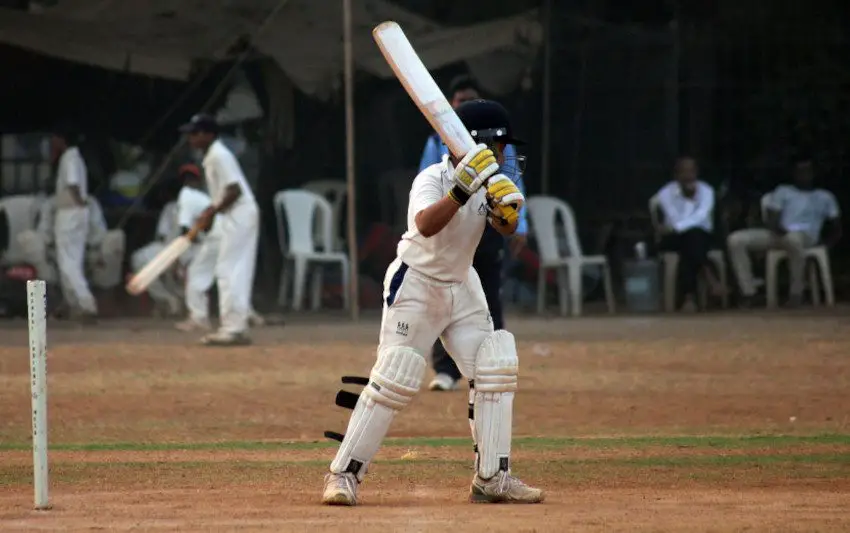Table of Contents
I’ve been lucky enough to watch cricket in four different countries so far – England, New Zealand Barbados and the Antigua. Obviously there is more to see and that list needs to be added to in the future.
During that time, I’ve also seen some wonderful stadiums: Cricket grounds fascinate me and, in this article, we’re going to look at some of the biggest – both in terms of capacity and dimensions.
If you just want to skip to the TOP 10 lists, click below:
Try This: Compare Cricket Ground Sizes In Interactive Tool
If you really want to know the difference between some of the largest cricket grounds in the world, the following tool will be your biggest help. The top 10 largest cricket grounds are listed according to their overall playing area determined by their straight and square boundaries.
Click on any of the cricket grounds listed on the right and compare their sizes!
Largest Cricket Grounds in the World by Boundary Length
Top 11 Largest Cricket Stadiums in the World by Boundary
The following grounds are ranked using their boundary measurements coupled with the overall playing surface. The playing area is determined using the straight boundaries multiplied by the square boundaries.
The final totals represent their rankings based on both criteria and we start with the biggest first.
#1 Melbourne Cricket Ground in Australia
Straight boundary: 83,43m
Square boundary: 86,235m
The Melbourne Cricket Ground staged the very first test match, between Australia and England, in 1877. The stadium has undergone many changes since that point and is now the biggest by area in the world.
The Centenary Test was also played here in 1977 and the MCG is traditionally used to host the Boxing Day test match against whichever country happens to be touring Australia.
#2 Sydney Cricket Ground in Australia
Straight boundary: 93,72m
Square boundary: 72,825m
Some Australian grounds are quite well known for their big playing surfaces and the Sydney Cricket Ground is another good example of this. A 93 metre boundary is almost unheard of in the modern game although this will typically be brought in for T20 matches.
The SCG traditionally hosts the first test of the New Year in Australia and its large surface area means that it is also used for other sports such as rugby league.
The SCG traditionally hosts the first test of the New Year in Australia and its large surface area means that it is also used for other sports such as rugby league.
#3 Singhalese Sports Club Cricket Ground in Colombo, Sri Lanka
Straight boundary: 86,095m
Square boundary: 77,02m
Widely known as the SSC, the Singhalese Sports Club Cricket Ground is the headquarters of the game in Sri Lanka. It had originally been established in 1952 and, when the Sri Lankans were admitted into test cricket back in 1982, the first test match was played here against New Zealand two years later.
Perhaps the most famous match on this big surface was a One Day International against Zimbabwe on their 2001/02 tour. Sri Lanka’s Chaminda Vaas took the best ODI figures of 8/19 while Zimbabwe’s total of 38 was the lowest in this format.
#4 Hagley Oval in Christchurch, New Zealand
Straight boundary: 83,575m
Square boundary: 77,455m
New Zealand used to play many of their games in Christchurch at the modest Lancaster Park but the Hagley Oval is much, much bigger. Cricket was first played here in 1867 but it wasn’t until December 2014 that New Zealand first played a test match at the Hagley Oval.
By the start of the new millennium, it was clear that international cricket had outgrown Lancaster Park and the replacement ground, which happens to have an extensive surface area, was set up.
#5 Basin Reserve in Wellington, New Zealand
Straight boundary: 81,7m
Square boundary: 72,48m
I haven’t been to the Basin Reserve but I have driven past it. It’s in an odd setting in New Zealand’s capital Wellington as it’s effectively in the middle of a roundabout. Not only are the boundaries long on all sides, the Basin Reserve is known for its windy conditions so batting can be very difficult here.
It’s the oldest cricket ground in the country and it has heritage status within New Zealand. The first test was played here against England in 1930 and it should be a regular host stadium for any touring nation.
#6 Lord’s Cricket Ground in London, United Kingdom
Straight boundary: 88,865m
Square boundary: 65,21m
This is the ground where I first watched test cricket, way back in 1975 and it’s still the one that I’ve visited the most. Supporters in England see Lord’s as the home of cricket and, as such, it should really have a large playing surface rather than ‘playground boundaries’ where it’s easy to hit 4s and 6s.
Another notable part of the Lord’s cricket ground is the famous slope. Running from the north to the south end of the surface, the total drop is 2.5 metres which can make it even more difficult for visiting batsmen.
Find out more about the best English cricket stadiums.
#7 Imperial Wanderers Stadium in Johannesburg, South Africa
Straight boundary: 86,755m
Square boundary: 64,135m
South Africa’s only current representative in the Top Ten is the Imperial Wanderers Stadium in Johannesburg. The ground replaced the Old Wanderers Stadium in 1956 and the first test match was played here in the same year.
The 2003 World Cup final was held at the new Wanderers but the most famous match was an ODI between South Africa and Australia in 2006. A world record score of 434 was made by Australia on first innings but the home side won after an incredible run chase.
#8 Kensington Oval in Bridgetown, Barbados
Straight boundary: 76,645m
Square boundary: 69,03m
In case you’re interested, the Kensington Oval was the first overseas cricket ground that I visited when England were touring the West Indies back in 1990. I can tell from watching on the television that the stadium is much different, thirty years later.
New stands have been built, the scoreboard has been replaced and the pavilion has been updated. What hasn’t changed is the vast surface area. The first test match was played here in 1930 while that extensive rebuild came ahead of the 2007 World Cup.
#9 Eden Gardens in Kolkata, India
Straight boundary: 76,23m
Square boundary: 66,26m
Eden Gardens is one of the most historic cricket stadiums in India and clearly it’s also one of the biggest. It’s the oldest ground in the country with the first test being played against England in 1934.
Many great games have been played here: The very first World Cup final outside of England was held at Eden Gardens back in 1987 and the ground would also host the World T20 final in 2016.
#10 The Narendra Modi Stadium (Motera): Ahmedabad, India
Straight Boundary: 75 metres
Square Boundary: 75 metres
When I originally wrote this article, the dimensions of the Narendra Modi Stadium (Motera) in Ahmedabad were yet to be confirmed. We knew that the venue was set to be the biggest in the world by capacity, but we were in the dark as far as the playing surface was confirmed.
2021 was an important year for the new stadium in Ahmedabad. It hosted its first test match as an upgraded facility, while the final of the Indian Premier League was held at the Narendra Modi ground a year later. Now that the venue has become established, the dimensions are confirmed at 180 x 150 yards, while the maximum lengths of the straight and square boundaries are all at 75 yards.
#11 Eden Park in Auckland, New Zealand
Straight boundary: 64,89m
Square boundary: 68,535m
You’ll have noticed that grounds in New Zealand appear regularly on this list. It could be because many of them are multi-purpose and can also be used for rugby and football.
Whatever the reason, Eden Park comes in at the bottom although the dimensions are still impressive. The first test match was played here in 1930 and the ground featured notably at the 2015 World Cup.
Differences in Boundary Length Between Cricket Formats
The entire playing surface of a ground does not always constitute the boundary area. Teams will generally adjust those boundaries according to the format of the game.
In test match and first class cricket, it’s important to have a balanced battle between bat and ball. For these matches, the boundaries will generally be extended to the entire length and width of the playing field.
For ODI and T20 matches, spectators want to see more runs from the batters and the boundaries will be brought in as a result.
It’s also worth remembering that the boundaries are rarely of even length. A cricket square will contain a number of pitches, and on the bigger grounds, there will be as many as 14 or more to choose from. Those grounds will host many matches across the season, and it’s not practical to use the same square for every game.
This will often mean that there is a shorter boundary on one side of the ground. Batters will target that boundary, while the bowling side will need to defend it adequately. Changing boundary length adds another dimension to cricket, giving the team captains something extra to think about.
Top 10 Largest Cricket Stadiums in the World by Capacity
Use our interactive world map for exploring some of the largest cricket grounds in the world. Each of the circles represent a cricket ground (the top 10 in red) and their sizes depend on their capacity.
Click and zoom in on the map to check out which are the biggest cricket grounds in the world!#1 Narendra Modi Stadium in Ahmedabad, India
One thing that was certain, even in the early stages of its development, was the fact that the Narendra Modi Stadium was set to become ground in the world when it comes to capacity. Now that the ground is open, it officially leads this particular section by a huge margin with space for an incredible 132,000 spectators.
The current round of expansion was finished in early 2020 although the stadium had been used much earlier. The first test match took place here between India and West Indies in 1983. After upgrades, the facility was reopened in 2020 and the first significant game saw India take on England in 2021. Ironically, there were no spectators inside the stadium as this was at the time of the global pandemic.
#2 Melbourne Cricket Ground in Melbourne, Australia
Before the Narendra Modi Stadium was refurbished, the Melbourne Cricket Ground was the only cricket facility with a 100,000 capacity. As we’ve seen, the first ever test match took place here in 1877. The Melbourne Cricket Ground has also served as the main stadium for the 1956 Summer Olympics – although cricket hasn’t been part of the Olympics since the first modern day Games.
Steady expansion from that point means that the capacity of the MCG today stands at 100,024.
#3 Eden Gardens in Kolkata, India
Eden Gardens is the only other stadium, aside from the MCG and the Narendra Modi, to appear on both of these lists. With a capacity of 68,000, it’s only in third place but that’s enough to dwarf the numbers from most cricket grounds.
As I write, there are plans to increase the capacity of Eden Gardens to 100,000 and we will update you as soon as this happens.
#4 Naya Raipur International Cricket Stadium in Raipur, India
A gap follows from Eden Gardens down to the Naya Raipur Stadium which sits in fourth place with a healthy capacity of 65,400. It has played host to the Delhi Capitals in the IPL and this is where I know it from.
Surprisingly, the venue has only recently started to host international cricket. The first ODI took place in January 2023, as India faced New Zealand, while T20i cricket followed in December 2023 as India took on Australia.
#5 Optus Stadium in Perth, Australia
I was one of a number of cricket fans who were disappointed to see the demise of the WACA – Perth’s previous cricket arena. However, it’s fair to say that the Optus Stadium is an impressive replacement.
With a declared capacity of exactly 65,000, it was officially opened in 2018 with a test match between Australia and India. Like a lot of Australian grounds, the Optus Stadium also hosts AFL plus rugby league. The arena can extend to accommodate 70,000 people for concerts.
#6 Greenfield International Stadium in Thiruvananthapuram, India
Also coming in with a capacity of 55,000 is the Greenfield International Stadium. A lot of us may not be familiar with grounds that aren’t regularly used in the Indian Premier League and this is another relatively new facility.
Opened in 2015, it’s so far only held limited overs internationals but this is yet another Indian ground which seems perfect for test cricket.
#7 Adelaide Oval in Adelaide, Australia
It’s one of the most historic grounds in Australia and it showcases some quaint, traditional architecture so it may be surprising to note just how big the Adelaide Oval is.
The official capacity is 53,583 for a ground that was first used for a test match way back in 1884. Among the many notable matches here is a one-run victory in a test between West Indies and Australia in 1992 – the narrowest margin in this form of the game. It’s another ground that can extend for concerts, and the current record attendance is 70,000 for an Adele gig in 2017.
Also, the Adelaide Oval is No. 1 stadium on our list of the 12 best cricket stadiums in Australia.
#8 M.A. Chidambaram Stadium in Chennai, India
Three Indian stadiums are in joint eighth place, each with a capacity of 50,000. The M.A. Chidambaram Stadium should be familiar to readers as it’s the regular home of the Chennai Super Kings. It’s also the second oldest ground in India, behind Eden Gardens.
This ground forms an important part of India’s cricket history. The first ever Ranji Trophy game was held here in 1936 but the most famous game was a tied test match between India and Australia in 1986 – only the second tied game in test history.
#9 JSCA International Cricket Stadium in Ranchi, India
The JSCA Stadium is much newer, having been established in 2011 but it also provides room for up to 50,000 cricket fans.
The Kolkata Knight Riders play here and it’s notable for its two hill stands which are the first of their kind in India.
#10 Ekana Cricket Stadium in Lucknow, India
Completing the full list is the Ekana Cricket Stadium in Lucknow which also clocks in at that overall capacity of 50,000. Indian women’s teams have played here but this stadium has become notable as it’s effectively the home ground of Afghanistan.
The Afghans played their first test here against the West Indies in 2019 and they’ve also been involved in ODIs and T20is. It’s interesting to note that India’s full men’s team have yet to use the Ekana for international cricket.
Since we first compiled this list, the Rajiv Gandhi International Cricket Stadium in Hyderabad, India has fallen off the radar. At the time, it stood at an impressive 55,000 capacity, but redevelopment ahead of the 2023 World Cup saw that drop to 39,400.
Adjusting Capacity
All information is correct at the time of writing, but will always be subject to change. Work is constantly being carried out to upgrade stadiums and those new stands will have an effect on overall capacity.
Some figures will go up, but others will decrease as the development continues.
We’ve also seen through this list that record capacities have been set for events other than cricket. For those grounds capable of holding concerts, it’s possible to free up part of the playing area to accommodate extra spectators.
Other grounds will open up areas of the field for the bigger games. For example, at Old Trafford in Manchester, some stands are closed for regular county matches, and these will become accessible for test matches.
In short, capacity is fluid, and these numbers are likely to change further in the future.
Closing Thoughts
What’s been interesting to note is that only two stadiums make it onto both of these lists. The logical conclusion to draw is that many grounds sacrifice ground capacity when they have a larger surface area.
It’s worthy of note that although many of these cricket grounds have some immense boundary lengths, yet some batsmen were able to hit sixes not only over the boundary, but out of the entire stadium.
It’s also been interesting to see the split between countries on the two separate lists. There’s a lot of New Zealand grounds in the surface area section while India features heavily in terms of capacity. There’s a lot more for me to see but how many of these have you been to?

